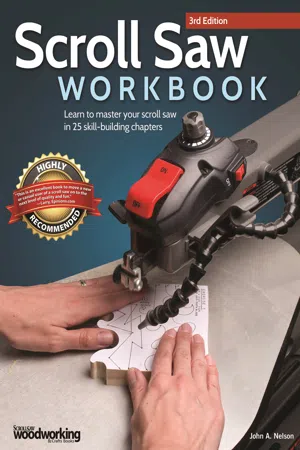
eBook - ePub
Scroll Saw Workbook, 3rd Edition
Learn to Master Your Scroll Saw in 25 Skill-Building Chapters
John A. Nelson
This is a test
Condividi libro
- 250 pagine
- English
- ePUB (disponibile sull'app)
- Disponibile su iOS e Android
eBook - ePub
Scroll Saw Workbook, 3rd Edition
Learn to Master Your Scroll Saw in 25 Skill-Building Chapters
John A. Nelson
Dettagli del libro
Anteprima del libro
Indice dei contenuti
Citazioni
Informazioni sul libro
The ultimate scroll saw beginner's guide to hone your scrolling skills to perfection. Practice a specific technique in each of 25 skill-building chapters, and then use that skill to make an attractive project. As you progress, each chapter builds upon the previous skills you've already learned. By the time you've completed the book, you'll be ready to tackle any scroll saw project with experience and confidence. This new third edition provides an objective guide to all of the new scroll saw models available in today's market, updated to include information on new scroll saw manufacturers.
Domande frequenti
Come faccio ad annullare l'abbonamento?
È semplicissimo: basta accedere alla sezione Account nelle Impostazioni e cliccare su "Annulla abbonamento". Dopo la cancellazione, l'abbonamento rimarrà attivo per il periodo rimanente già pagato. Per maggiori informazioni, clicca qui
È possibile scaricare libri? Se sì, come?
Al momento è possibile scaricare tramite l'app tutti i nostri libri ePub mobile-friendly. Anche la maggior parte dei nostri PDF è scaricabile e stiamo lavorando per rendere disponibile quanto prima il download di tutti gli altri file. Per maggiori informazioni, clicca qui
Che differenza c'è tra i piani?
Entrambi i piani ti danno accesso illimitato alla libreria e a tutte le funzionalità di Perlego. Le uniche differenze sono il prezzo e il periodo di abbonamento: con il piano annuale risparmierai circa il 30% rispetto a 12 rate con quello mensile.
Cos'è Perlego?
Perlego è un servizio di abbonamento a testi accademici, che ti permette di accedere a un'intera libreria online a un prezzo inferiore rispetto a quello che pagheresti per acquistare un singolo libro al mese. Con oltre 1 milione di testi suddivisi in più di 1.000 categorie, troverai sicuramente ciò che fa per te! Per maggiori informazioni, clicca qui.
Perlego supporta la sintesi vocale?
Cerca l'icona Sintesi vocale nel prossimo libro che leggerai per verificare se è possibile riprodurre l'audio. Questo strumento permette di leggere il testo a voce alta, evidenziandolo man mano che la lettura procede. Puoi aumentare o diminuire la velocità della sintesi vocale, oppure sospendere la riproduzione. Per maggiori informazioni, clicca qui.
Scroll Saw Workbook, 3rd Edition è disponibile online in formato PDF/ePub?
Sì, puoi accedere a Scroll Saw Workbook, 3rd Edition di John A. Nelson in formato PDF e/o ePub, così come ad altri libri molto apprezzati nelle sezioni relative a Technology & Engineering e Technical & Manufacturing Trades. Scopri oltre 1 milione di libri disponibili nel nostro catalogo.
Informazioni
Exercise 1
Objective: Practice following straight lines, wavy lines, making sharp corners and turning in place.
Materials needed:
(1) ¾" x 5 ½"–7 ¼" long piece of wood
#5 skip-tooth blade
Step 1: Make a copy of Exercise 1 and attach it to a knot-free piece of pine or similar wood.
Step 2: Review the four “Getting Started” steps here.
Step 3: Stand or sit directly in front of the saw. Relax and take a deep breath.
Step 4: Hold your fingers as if you were working on a computer keyboard-use the tips of your fingers. If you are right-handed, use your left hand to lightly hold down the wood. Place your left index finger about 1" directly to the left of the blade. This index finger will help you rotate the wood when you make turns. Use your right hand to steer the wood along the straight line. (If you are left-handed, reverse the instructions.) Remember: Use your finger tips, not your hands and body, to hold and steer the wood, as if you were driving a car along a road.
Step 5: To make a straight cut: Align the blade with the end of the pattern and wood at “A.” Take a deep breath and relax. Lightly push the wood into the blade; let the blade do the cutting. Again, relax. I cannot stress this enough! Be sure your left hand is lightly holding the wood down. Keep in mind, the teeth of the scroll saw blade are in front of the blade facing you. This is where the blade cuts, not on the side or back of the blade. Many people do not realize this their first time using a scroll saw. Complete the straight line cut. If you get off the line, slowly turn the wood to get back on the line. Do not push the blade sideways. Try one more straight line at “A.”
Step 6: To make a curved, wavy line: Follow the same steps as in #5. Practice cutting wavy lines along the two lines marked “B.”
Step 7: To make sharp turns: Start cutting in at “C.” When you reach each large dot on the pattern, stop pushing the wood—relax—and back off slightly. With your left index finger about 1" to the left of the blade, rotate the wood to line up with the direction of the line. Continue cutting. Each time you get to a dot follow the instructions above.
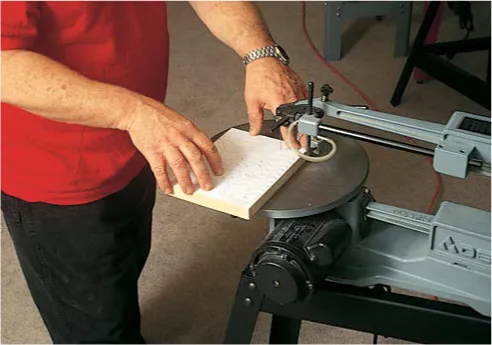

Step 8: To make turns in place: Cut in at “D.” With your left index finger 1" to the left of the blade, rotate the wood at the dot and cut your way back out along the existing saw kerf you just made. Do not back out. Practice at the other “D” lines.
Step 9: Practice making waves, curves and sharp turns at “E.” Again, stop at each dot, relax, back off slightly, turn, and cut.
Step 10: If you still have problems and need more practice, make another copy of Practice Exercise 1 and repeat steps 2 through 9.

Exercise 1
¾" x 5½"–7¼"
#5 Skip-Tooth Blade
¾" x 5½"–7¼"
#5 Skip-Tooth Blade
Exercise 2
Objective: To cut out a simple object, following lines to produce a smooth, continuous, flowing cut.
Materials needed:
(1) ¾" x 4 ½"–5 ½" long piece of wood
#5 skip-tooth blade
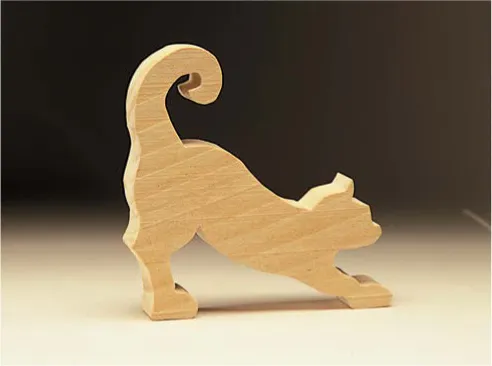
Step 1: Make a copy of Exercise 2 and attach it to a knot-free piece of pine or similar wood.
Step 2: Review the four “Getting Started” steps here.
Step 3: Stand or sit directly in front of the saw. Relax and take a deep breath.
Step 4: Using only your fingertips and a light touch, cut in as indicated. Make a smooth, continuous, flowing cut all the way around without stopping.
Note: If you wander off the cutting line outside of the pattern, stop and back up to where you wandered off. Continue cutting out your pattern (see figure 1). If you wander off the cutting line inside of the pattern, keep cutting slowly and smoothly back to the pattern line (see figure 2). Remember, after you remove the pattern from the wood, no one will know you were off the line.
Step 5: When you have the project all cut out, check the edges. You should have a continuous, smooth surface all around. If not, make another copy of the pattern and repeat Steps 1 through 4 with a new piece of wood until it is perfect. PRACTICE MAKES PERFECT!
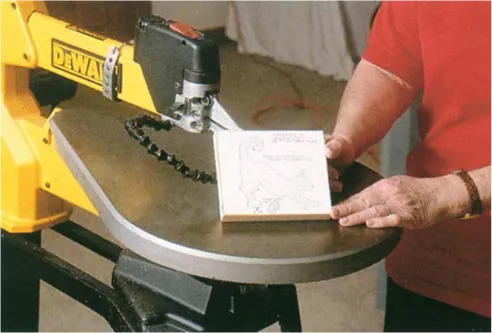

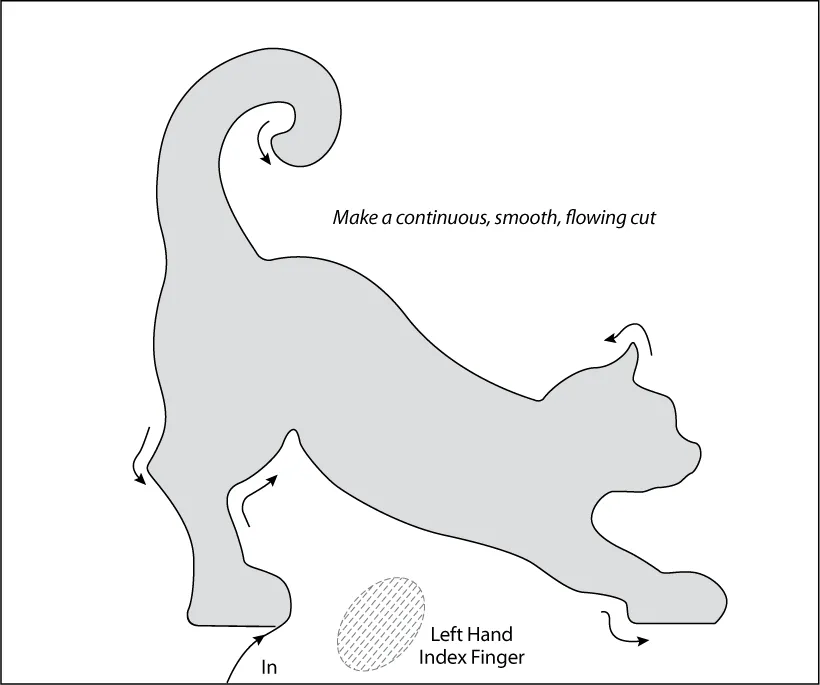
Exercise 2
¾" x 4½"–5½"
#5 Skip-Tooth Blade
¾" x 4½"–5½"
#5 Skip-Tooth Blade

Figure 1
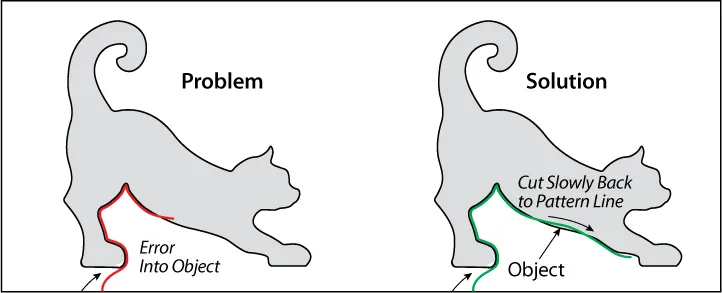
Figure 2
Exercise 3
Objective: To cut out a simple object, fo...